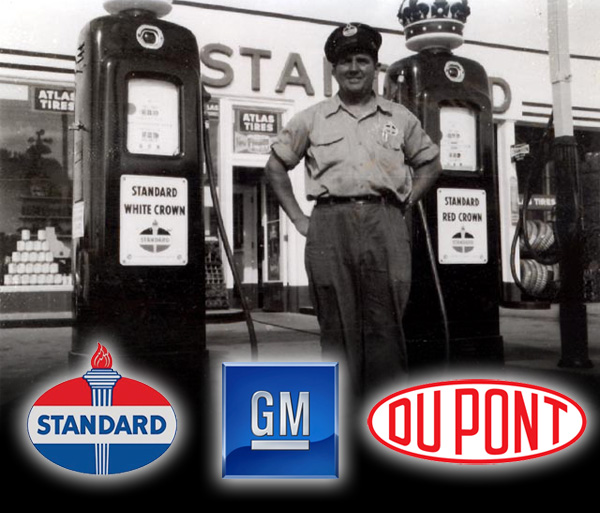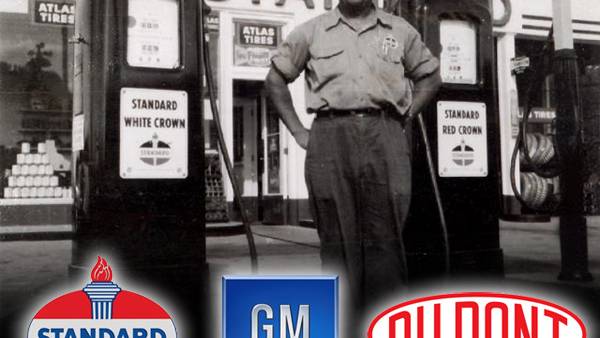The Secret History of Lead
Source: thenation.com

This article appeared in the March 20, 2000 edition of The Nation.
The next time you pull the family barge in for a fill-up, check it out: The gas pumps read "Unleaded." You might reasonably suppose this is because naturally occurring lead has been thoughtfully removed from the gasoline. But you would be wrong. There is no lead in gasoline unless somebody puts it there. And, a little more than seventy-five years ago, some of America's leading corporations--General Motors, Du Pont and Standard Oil of New Jersey (known nowadays as Exxon)--were that somebody. They got together and put lead, a known poison, into gasoline, for profit.
Lead was outlawed as an automotive gasoline additive in this country in 1986--more than sixty years after its introduction--to enable the use of emissions-reducing catalytic converters in cars (which are contaminated and rendered useless by lead) and to address the myriad health and safety concerns that have shadowed the toxic additive from its first, tentative appearance on US roads in the twenties, through a period of international ubiquity only recently ending. Since the virtual disappearance of leaded gas in the United States (it's still sold for use in propeller airplanes), the mean blood-lead level of the American population has declined more than 75 percent. A 1985 EPA study estimated that as many as 5,000 Americans died annually from lead-related heart disease prior to the country's lead phaseout. According to a 1988 report to Congress on childhood lead poisoning in America by the government's Agency for Toxic Substances and Disease Registry, one can estimate that the blood-lead levels of up to 2 million children were reduced every year to below toxic levels between 1970 and 1987 as leaded gasoline use was reduced. From that report and elsewhere, one can conservatively estimate that a total of about 68 million young children had toxic exposures to lead from gasoline from 1927 to 1987.
How did lead get into gasoline in the first place? And why is leaded gas still being sold in the Third World, Eastern Europe and elsewhere? Recently uncovered documents from the archives of the aforementioned industrial behemoths and the US government, a new skein of academic research and a careful reading of that long-ago period's historical record, as well as dozens of interviews conducted by The Nation, tell the true story of leaded gasoline, a sad and sordid commercial venture that would tiptoe its way quietly into the black hole of history if the captains of industry were to have their way. But the story must be recounted now. The leaded gas adventurers have profitably polluted the world on a grand scale and, in the process, have provided a model for the asbestos, tobacco, pesticide and nuclear power industries, and other twentieth-century corporate bad actors, for evading clear evidence that their products are harmful by hiding behind the mantle of scientific uncertainty.
This is not just a textbook example of unnecessary environmental degradation, however. Nor is this history important solely as a cautionary retort to those who would doubt the need for aggressive regulation of industry, when commercial interests ask us to sanction genetically modified food on the basis of their own scientific assurances, just as the merchants of lead once did. The leaded gasoline story must also be read as a call to action, for the lead menace lives.
Consider:
§ the severe health hazards of leaded gasoline were known to its makers and clearly identified by the US public health community more than seventy-five years ago, but were steadfastly denied by the makers, because they couldn't be immediately quantified;
§ other, safer antiknock additives--used to increase gasoline octane and counter engine "knock"--were known and available to oil companies and the makers of lead antiknocks before the lead additive was discovered, but they were covered up and denied, then fought, suppressed and unfairly maligned for decades to follow;
§ the US government was fully apprised of leaded gasoline's potentially hazardous effects and was aware of available alternatives, yet was complicit in the cover-up and even actively assisted the profiteers in spreading the use of leaded gasoline to foreign countries;
§ the benefits of lead antiknock additives were wildly and knowingly overstated in the beginning, and continue to be. Lead is not only bad for the planet and all its life forms, it is actually bad for cars and always was;
§ for more than four decades, all scientific research regarding the health implications of leaded gasoline was underwritten and controlled by the original lead cabal--Du Pont, GM and Standard Oil; such research invariably favored the industry's pro-lead views, but was from the outset fatally flawed; independent scientists who would finally catch up with the earlier work's infirmities and debunk them were--and continue to be--threatened and defamed by the lead interests and their hired hands;
§ confronted in recent years with declining sales in their biggest Western markets, owing to lead phaseouts imposed in the United States and, more recently, Europe, the current sellers of lead additives have successfully stepped up efforts to market their wares in the less-developed world, efforts that persist and have resulted in some countries today placing more lead in their gasoline, per gallon, than was typically used in the West, extra lead that serves no purpose other than profit;
§ faced with lead's demise and their inevitable days of reckoning, these firms have used the extraordinary financial returns that lead additive sales afford to hurriedly fund diversification into less risky, more conventional businesses, while taking a page from the tobacco companies' playbook and simultaneously moving to reorganize their corporate structures to shield ownership and management from liability for blanketing the earth with a deadly heavy metal.
You can choose whether to smoke, but you can't pick the air you breathe, even if it is contaminated by lead particles from automobile exhaust. Seventy-five years ago, well-known industrialists like GM's Alfred Sloan and Charles Kettering (remembered today for having founded the prestigious Memorial Sloan-Kettering Cancer Center) and the powerful brothers Pierre and Irénée du Pont added to their substantial fortunes and did the planet very dirty by disregarding the common-sense truth that no good can come from burning a long-known poison in internal-combustion engines.
The steady emergence of improved methodology and finer, more sensitive measuring equipment has allowed scientists to prove lead's tragic toll with increasing precision. The audacity of today's lead-additive makers' conduct mounts with each new study weighing in against them. Because lead particles in automobile exhaust travel in wind, rain and snow, which know no national boundaries, lead makers and refiners who peddle leaded gasoline knowingly injure not only the local populations using their product but men, mice and fish tens of thousands of miles distant.
GM and Standard Oil sold their leaded gasoline subsidiary, the Ethyl Gasoline Corporation, to Albemarle Paper in 1962, while Du Pont only cleaned up its act recently, but all hope to leave their leaded gasoline paternity a hushed footnote to their inglorious pasts. The principal maker of lead additive today the Associated Octel Company of Ellesmere Port, England) and its foremost salesmen (Octel and the Ethyl corporation of Richmond, Virginia) acknowledge what they see as a political reality: Their product will one day be run out of business. But they plan to keep on selling it in the Third World profitably until they can sell it no longer. They continue to deny lead's dangers while overrating its virtues, reprising the central tenets of the lead mythology chartered by GM, Du Pont and Standard lifetimes ago.
These mighty corporations should pay Ethyl and Octel for keeping their old lies alive. They'll need them, in their most up-to-the-minute and media-friendly fashion: Because of the harm caused by leaded gasoline they have been joined to a class-action suit brought in a circuit court in Maryland against the makers of that other product of lead's excruciating toxic reign: lead paint. Along with the makers of lead paint and the lead trade organizations with whom they both once worked in close concert, suppliers and champions of lead gasoline additives--Ethyl, Du Pont and PPG--have been named as defendants in the suit.
Though the number of cases of lead poisoning has been falling nationwide, the lead dust in exhaust spewed by automobiles in the past century will continue to haunt us in this one, coating our roads, buildings and soil, subtly but indefinitely contaminating our homes, belongings and food.
The Problem With Lead
Lead is poison, a potent neurotoxin whose sickening and deadly effects have been known for nearly 3,000 years and written about by historical figures from the Greek poet and physician Nikander and the Roman architect Vitruvius to Benjamin Franklin. Odorless, colorless and tasteless, lead can be detected only through chemical analysis. Unlike such carcinogens and killers as pesticides, most chemicals, waste oils and even radioactive materials, lead does not break down over time. It does not vaporize, and it never disappears.
For this reason, most of the estimated 7 million tons of lead burned in gasoline in the United States in the twentieth century remains--in the soil, air and water and in the bodies of living organisms. Worldwide, it is estimated that modern man's lead exposure is 300 to 500 times greater than background or natural levels. Indeed, a 1983 report by Britain's Royal Commission on Environmental Pollution concluded that lead was dispersed so widely by man in the twentieth century that "it is doubtful whether any part of the earth's surface or any form of life remains uncontaminated by anthropogenic [man-made] lead." While lead from mining, paint, smelting and other sources is still a serious environmental problem, a recent report by the government's Agency for Toxic Substances and Disease Registry estimated that the burning of gasoline has accounted for 90 percent of lead placed in the atmosphere since the 1920s. (The magnitude of this fact is placed in relief when one considers the estimate of the US Public Health Service that the associated health costs from a parallel problem--the remaining lead paint in America's older housing--total in the multibillions.)
Classical acute lead poisoning occurs at high levels of exposure, and its symptoms--blindness, brain damage, kidney disease, convulsions and cancer--often leading, of course, to death, are not hard to identify. The effects of pervasive exposure to lower levels of lead are more easily miscredited; lead poisoning has been called an "aping disease" because its symptoms are so frequently those of other known ailments. Children are the first and worst victims of leaded gas; because of their immaturity, they are most susceptible to systemic and neurological injury, including lowered IQs, reading and learning disabilities, impaired hearing, reduced attention span, hyperactivity, behavioral problems and interference with growth. Because they often go undetected for some time, such maladies are particularly insidious. In adults, elevated blood-lead levels are related to hypertension and cardiovascular disease, particularly strokes, heart attacks and premature deaths. Lead exposure before or during pregnancy is especially serious, harming the mother's own body, affecting fetal development and frequently leading to miscarriage. In the eighties the EPA estimated that the health damages from airborne lead cost American society billions each year. In Venezuela, where the state oil company sold only leaded gasoline until 1999, a recent report found 63 percent of newborn children with blood-lead levels in excess of the so-called safe levels promulgated by the US government.
The Search for an Antiknock
On December 9, 1921, a young engineer named Thomas Midgley Jr., working in the laboratory of the General Motors Research Corporation in Dayton, Ohio, reported to his boss, Charles Kettering, that he'd discovered that tetraethyl lead--a little-known compound of metallic lead and one of the alkyl series, also referred to as lead tetraethyl or TEL--worked to reduce "knock" or "pinging" in internal-combustion engines.
Tetraethyl lead was first discovered by a German chemist in 1854. A technical curiosity, it was not used commercially on account of "its known deadliness." It is highly poisonous, and even casual cumulative contact with it was known to cause hallucinations, difficulty in breathing and, in the worst cases, madness, spasms, palsies, asphyxiation and death. Still unused in 1921, sixty-seven years after its invention, it was not an obvious choice as a gasoline additive.
In the laboratories of Charles Kettering, however, the search for a gasoline additive to cure "knock" had been going on for some years prior to Midgley's rediscovery of TEL. In 1911 Kettering had invented the electric self-starter--a landmark development in automotive history that eliminated dangerous hand-cranking and enabled many Americans (particularly women) to drive for the first time, arguably killing steam and electric cars in the process. This invention would make "Boss" Kettering rich, famous and beloved to a nation falling in love with its wheels. Thanks to the starter, the folksy inventor's new firm, Dayton Engineering Laboratories Company, or DELCO, received its first big order, for $10 million, from the upstart General Motors Corporation, founded only three years earlier by William Crapo Durant.
GM's 1912 Cadillac was equipped with DELCO's self-starter and battery ignition. When customers reported that the engine of this luxury automobile had an alarming tendency to knock--a sharp, metallic sound hinting at damage being done inside the engine--critics blamed Kettering's electrical components.
Kettering was convinced, rightly, that knocking was a function of an engine's fuel rather than ignition problems. When Kettering and his partners sold DELCO to Durant's GM and its new partner--Alfred Sloan's Hyatt Roller Bearings--in 1916, his lab was already engaged in a search for the cure. Following the sale, this work was transferred to his new firm, the Dayton Research Laboratories, where a newly hired assistant, Thomas Midgley, was assigned to study the problem of engine knock.
Stabbing in the dark, Midgley got lucky quickly when he added iodine to the fuel, stopping knock in a test engine and establishing for all time that the malady--premature combustion of the fuel/air mixture--was connected to the explosive qualities of the fuel, what would later be called "octane." Iodine raised octane and cured knock; however, it was corrosive and prohibitively expensive. Inspired by the fundamental breakthrough, Midgley nonetheless carried on with fuel research, testing every substance he could find for antiknock properties, "from melted butter and camphor to ethyl acetate and aluminum chloride." Unfortunately, "most of them had no more effect than spitting in the Great Lakes."
Read the Rest of the Story: here






















